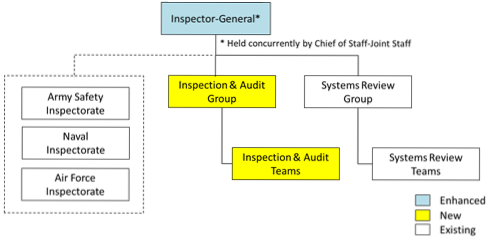 Fact Sheet: Establishment of the Singapore Armed Forces Inspector-General Office
Fact Sheet: Establishment of the Singapore Armed Forces Inspector-General Office
The Singapore Armed Forces (SAF) Inspector-General Office (IGO) will be set up in the early half of 2019 to intensify the scrutiny of safety practices at all levels and across all Services and units in the SAF. The IGO will be vested with full authority to conduct independent audits and inspections within the SAF, in addition to taking on the existing responsibilities of the Safety and Systems Review Directorate (SSRD).
The IGO: An Expanded SSRD Enhanced with Independent Inspection and Audit Functions
SSRD will be expanded and elevated to form the IGO, and led by the SAF Inspector-General, who will report jointly to the Permanent Secretary (Defence) and the Chief of Defence Force (CDF). Chief of Staff-Joint Staff (COS-JS), which is an existing appointment in the Office of the CDF with the seniority of a Service Chief equivalent, will be the SAF Inspector-General.
Figure 1: Structure of the IGO

The IGO's Additional Functions. The IGO will strengthen the existing SAF safety structure. It will have the powers to carry out independent audits on: (i) the implementation of SAF's safety policy and objectives; (ii) the safety culture across Service and Formation HQs; (iii) the safety management systems at the Service and Formation levels; and (iv) the command emphasis on safety, specifically whether commanders have nurtured and are sustaining a safety culture. In its first year, the IGO will focus its efforts on high-risk training and safety culture checks. The IGO will also investigate any report of poor safety practices and culture at any level within the SAF. Safety lapses found will be surfaced to the CDF directly for further investigation and appropriate disciplinary actions. The IGO will also submit regular SAF safety performance report to the Minister for Defence.
The IGO will take on SSRD's existing responsibilities to convene external review panels and conduct external benchmarking of safety practices and standards, review safety-related reports including those of the Committees of Inquiry, and review specific MINDEF/SAF systems as required.
Multi-layered SAF Safety Structure
The SAF safety structure is organised into three levels – strategic, operational, and tactical – ensuring that sufficient emphasis is given to safety at all levels of the organisation.
a. Strategic Leadership Level. The SAF leadership sets the safety policies and provides key directions on safety efforts. The IGO will continue to tap on the expertise of safety professionals from the public and private sectors to continuously enhance the SAF safety system, such as the External Review Panel on SAF Safety (ERPSS). Between 2013 and 2016, the first ERPSS, led by Mr Alan Chan, then CEO of SPH Holdings, conducted 14 visits to SAF Formations, units and exercises. The ERPSS observed that there is strong command emphasis on safety in the SAF and that rigorous safety management processes have been put in place, and recommended strengthening the safety culture on the ground. The second ERPSS, inaugurated on 27 July 2017, is chaired by Mr Heng Chiang Gnee, Director MMA Offshore Limited (Chairman, Workplace Safety and Health Council from Apr 2016 to Mar 2018). The second ERPSS was briefed on the SAF and Army safety management systems and also conducted visits to various Formations and units. The Panel continued to emphasise the importance of a strong safety culture in all SAF units, commanders and supervisors leading by example in emphasising safety as a way of life, and soldiers having a strong respect for safety rules, taking care of one another and speaking out on safety concerns.
b. Operational Level. The Safety Inspectorates in the Army, Navy and Air Force maintain oversight and drive the implementation of their respective Service safety policies, standards and culture. The Safety Inspectorates conduct: (i) annual compliance audits on the safety management systems of all units; and (ii) up to four training safety inspections per unit per year.
c. Tactical Level. At this level, Formation and unit commanders play critical roles in ensuring safety on the ground. All commanders are educated on the SAF's Training Safety Regulations (TSRs) , undergo safety training, and are taught to take care of their men in command school. They are supported by their Formation and unit safety officers who are responsible for the safe execution of activities through the conduct of safety briefings, training inspections and risk assessments to ensure compliance with SAF TSRs.
Open Reporting a Key Tenet of SAF Safety Culture
Open reporting and regular feedback is encouraged as part of efforts to continually enhance the safety management system. There are avenues for soldiers to speak up and provide feedback on safety issues. Safety surveys are conducted regularly amongst national servicemen to solicit their views on training safety. Individual soldiers are also encouraged to report any risky behaviour and safety breaches that they encounter to their superiors without fear of reprisals. Servicemen can also report safety incidents, near-misses, and hazards through the 24-hour safety hotline. In addition, servicemen and members of the public may provide feedback on safety lapses to the MINDEF Feedback Unit.
In one example, a full-time national serviceman spotted two servicemen, who were not wearing helmets, driving a Light Strike Vehicle (LSV). The two servicemen were stopped at that point for violating driving safety regulations. Upon questioning, it was discovered that they were not authorised to drive the LSV. Both of them were punished accordingly. Servicemen found to have committed safety lapses will be prosecuted by Summary Trial or General Court Martial. Sentences can include reprimands, fines, and detention.
